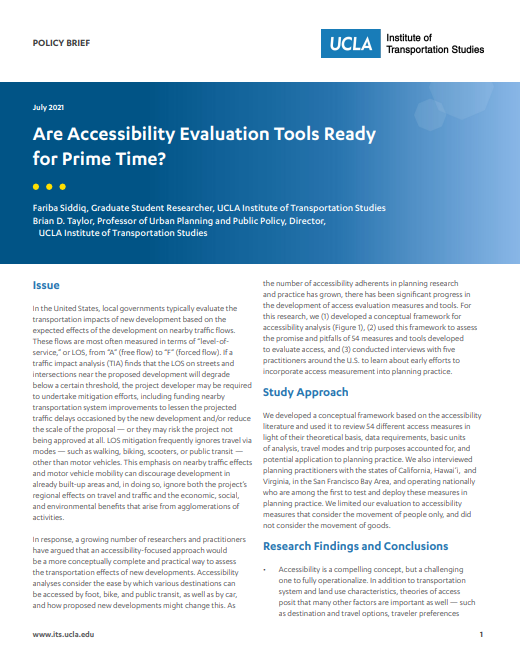Date: July 1, 2021
Author(s): Fariba Siddiq, Brian D. Taylor
Abstract
In the United States, local governments typically evaluate the transportation impacts of new development based on the expected effects of the development on nearby traffic flows. These flows are most often measured in terms of “level-of-service,” or LOS. If a traffic impact analysis (TIA) finds that the LOS on streets and intersections near the proposed development will degrade below a certain threshold, the project developer may be required to undertake mitigation efforts. LOS mitigation frequently ignores travel via modes other than motor vehicles. This emphasis on nearby traffic effects and motor vehicle mobility can discourage development in already built-up areas and, in doing so, ignore both the project’s regional effects on travel and traffic and the economic, social, and environmental benefits that arise from agglomerations of activities. There is a push for an accessibility-focused approach to assess the transportation effects of new developments. For this research, we (1) developed a conceptual framework for accessibility analysis (Figure 1), (2) used this framework to assess the promise and pitfalls of 54 measures and tools developed to evaluate access, and (3) conducted interviews with five practitioners around the U.S. to learn about early efforts to incorporate access measurement into planning practice
About the Project
For decades evaluation of the benefits and costs of new- or re- development in urban areas has centered on the effects of development on nearby traffic flows. Historically, and in most states outside of California, the level-of-service (LOS) scale has been used to approve or disapprove commercial developments. The logic of such an evaluation model is that smooth traffic flows are a primary goal of urban areas, which has the effect of discouraging the sorts of densely developed places that are more easily accessed by foot, bike, shared mobility, and public transit. To overcome the traffic flow focus of traffic impact analyses, the California legislature passed SB 743 in 2013, which mandated a change in the way that transportation impacts are analyzed under CEQA. New CEQA Guidelines were created to replace LOS with a new focus on how proposed developments affect vehicle miles of travel (VMT). This translational project will build on prior research, as well as the burgeoning literature on operationalizing access into transportation planning and engineering to develop and test some new analytical tools to evaluate the access impacts of developments.


